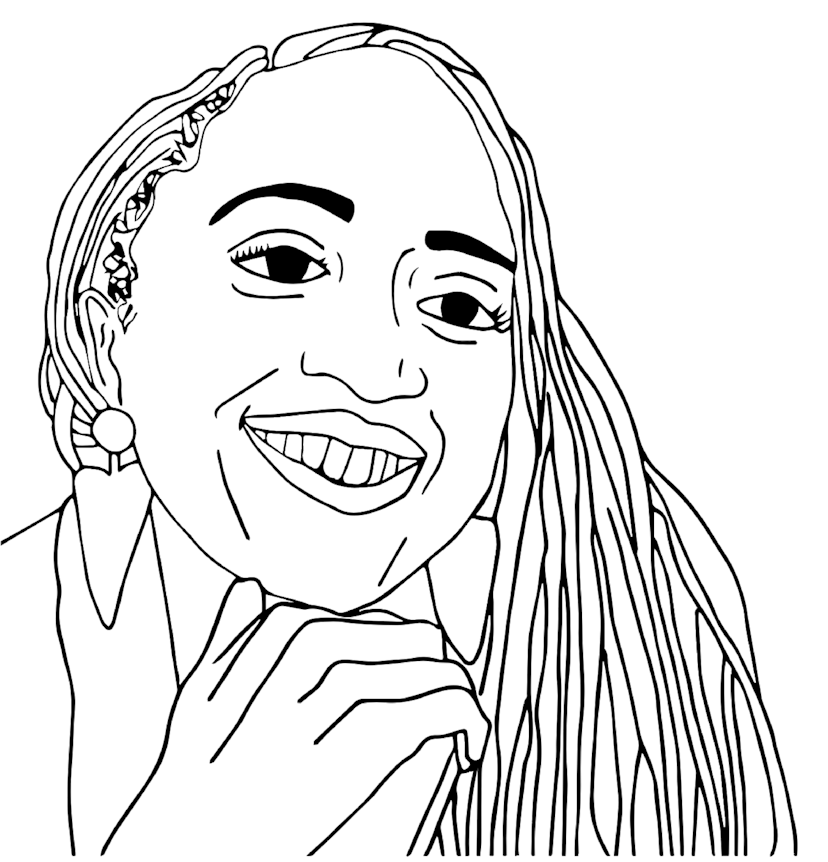A couple of years ago, I raced out of work and onto the Rose Kennedy Greenway’s walking path in search of lunch. On the way to the food trucks, I saw people lounging on colorful blankets and chairs. After grabbing my meal, I joined a group on the grass and listened to a lush soundscape by Dzidzor. From speakers, declarations of liberation and openness spoken over ambient sounds washed over me under summer’s sun. I dropped my tense shoulders and laughed with strangers.
The event, inPUBLIC: Rest, was organized by the Design Studio for Social Intervention in Dorchester—whose work sits at the “intersections of design thinking and practice, social justice and activism, public art and social practice, and civic/ popular engagement”—as part of a series featuring poems, music, family portraits, and more.
That project is one example of how, at its best, public art assembles us together, spurs conversation, and inspires us to find meaning. Local curators as well as artists and policy makers have been working to create moments like these, when art does much more than just turn heads and elicit photos. Engagement between artist and audience seems to be a key component for developing resonant artwork that highlights what’s important to a community and inspires people to rally around it.
An installation in Chin Park speaks to that sentiment. Local artist Ponnapa Prakkamakul’s Year of the Dragon was co-designed by Chinatown residents. Prakkamakul’s piece, a seven-foot-tall interactive dragon named Ju Long Ju Long, meaning “Giant Dragon, Gathering Dragon,” features stairs to climb, a drum to bang, a kaleidoscope to peer through, and panels etched with words in English and Chinese expressing residents’ wishes for the neighborhood, which they shared during co-creation workshops. In June, the artist will install the dragon’s tail, a sixty-foot vinyl ground mural created with the A-VOYCE youth organization. And that month, everyone can celebrate the work at a dragon boat festival.
“Public art deepens connections between communities and their public spaces,” said Dr. Audrey Lopez, director and curator of public art at the Greenway. She shared that she’s excited about excavating and elevating Boston’s lesser-known stories and histories through art. And she’s also eager to continue engaging communities in the process of creating public artwork.
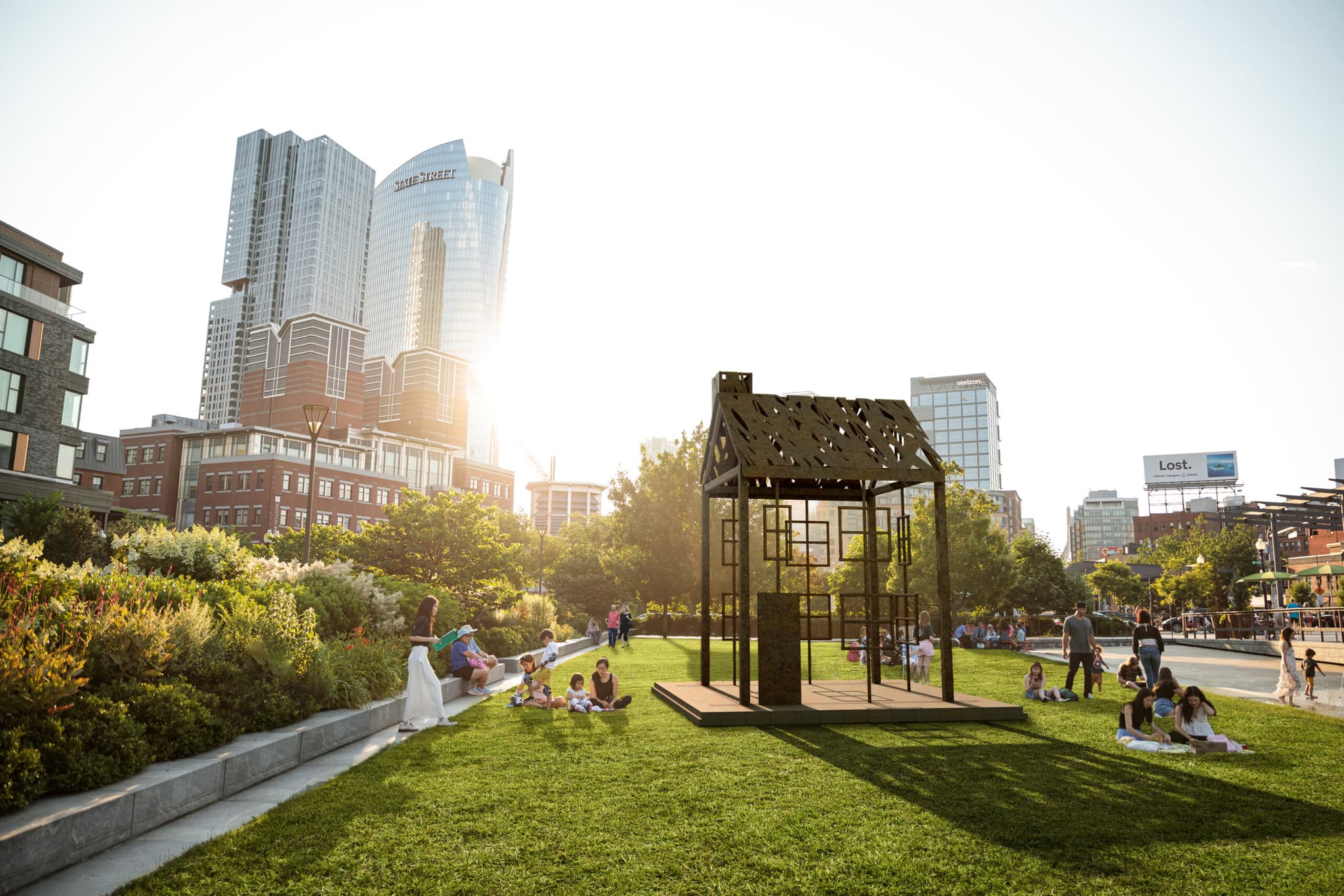
LaRissa Rogers, Going to Ground, 2024. Mock-up for The Rose Kennedy Greenway. Courtesy of the artist.
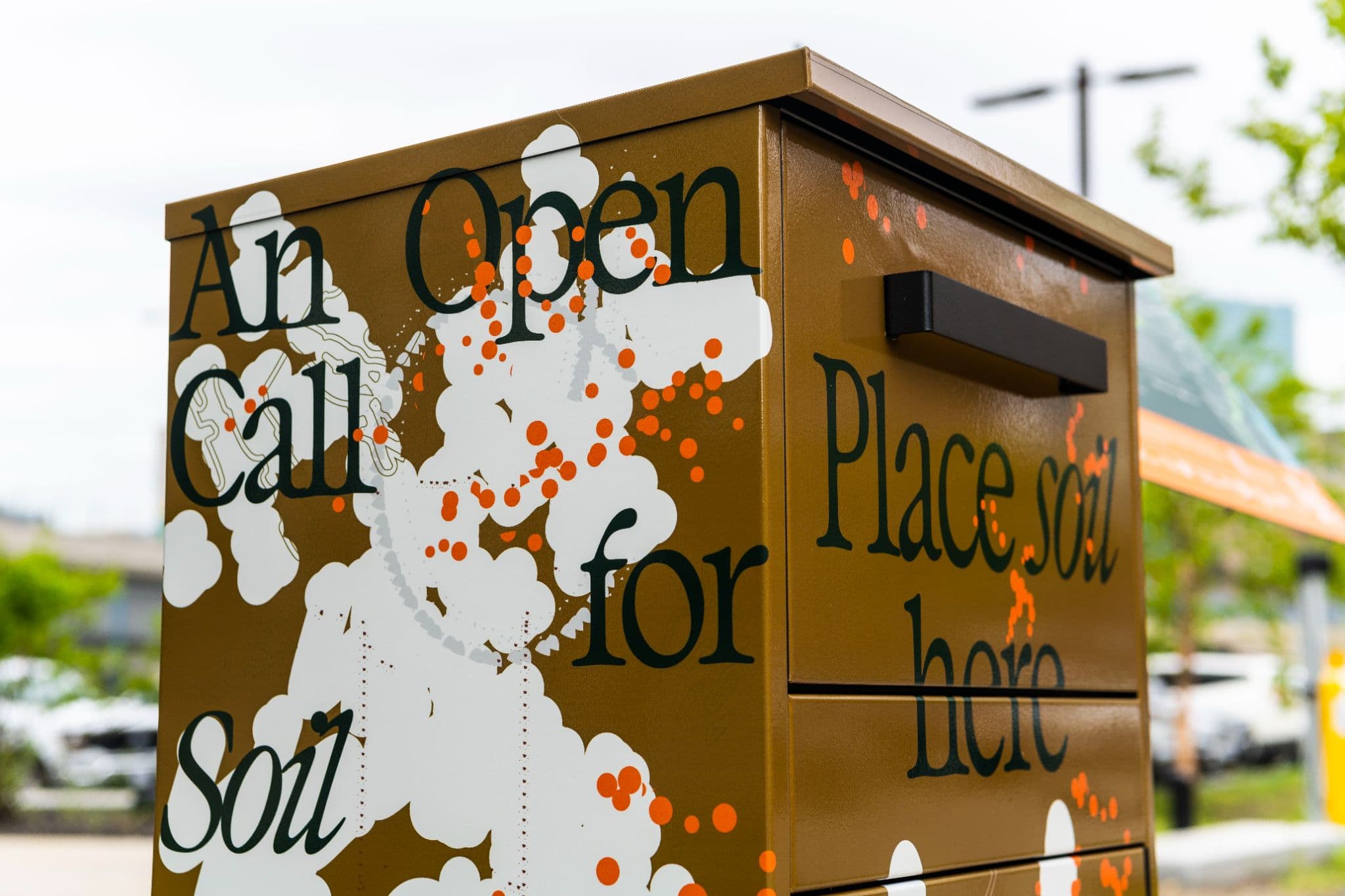
An Open Call for Soil box installed in downtown Boston as part of artist LaRissa Rogers’s upcoming project, Going to Ground, 2024. Photo by Lee-Daniel Tran. Graphic design by Chen Luo. Courtesy of The Rose Kennedy Greenway.
Artist LaRissa Rogers’s installation Going to Ground, coming to the Greenway in August, aims to do both. Rogers is based in Virginia and Los Angeles, but she’s spent much of the past year in Massachusetts for a fellowship at Provincetown’s Fine Arts Work Center, and this work is quite literally grounded in Boston. Going to Ground draws inspiration from Zipporah Potter Atkins, who in 1670 became the first Black woman to own a home in Boston, once located on a site now cared for by the Greenway in the North End. The artist will construct the outline of Atkins’s home in steel atop a foundation of adobe bricks made from soil collected via an open call to Boston’s communities. Members of the public will be able to witness a performance of the laying of the adobe bricks and attend a picnic honoring Dr. Vivian Johnson, associate professor emerita at Boston University, who found Atkins’s signed deed in her research.
Meanwhile in Dorchester, multimedia artist Ngoc-Tran Vu’s latest project is likewise getting locals involved in the art-making process. Vu—whose work centers on familial ties, memories, and ritual—has been mobilizing the Vietnamese community in Boston’s Little Saigon neighborhood through a series of monthly conversations. In April, Vu also hosted an intergenerational cultural commemoration in remembrance of the Fall of Saigon on April 30, 1975, a day known as Black April that’s often seen as marking the start of the Southern Vietnamese diaspora. This relationship building and continued resident feedback will inform Vu’s 1975: A Vietnamese Diaspora Memorial in 2025, the fiftieth anniversary of the war’s end. Vu plans to have a 3D model for residents to respond to this summer, and the memorial is part of a larger effort that includes the collecting, sharing, and archiving of oral stories reflecting perspectives that are often omitted from historical narratives about the war.
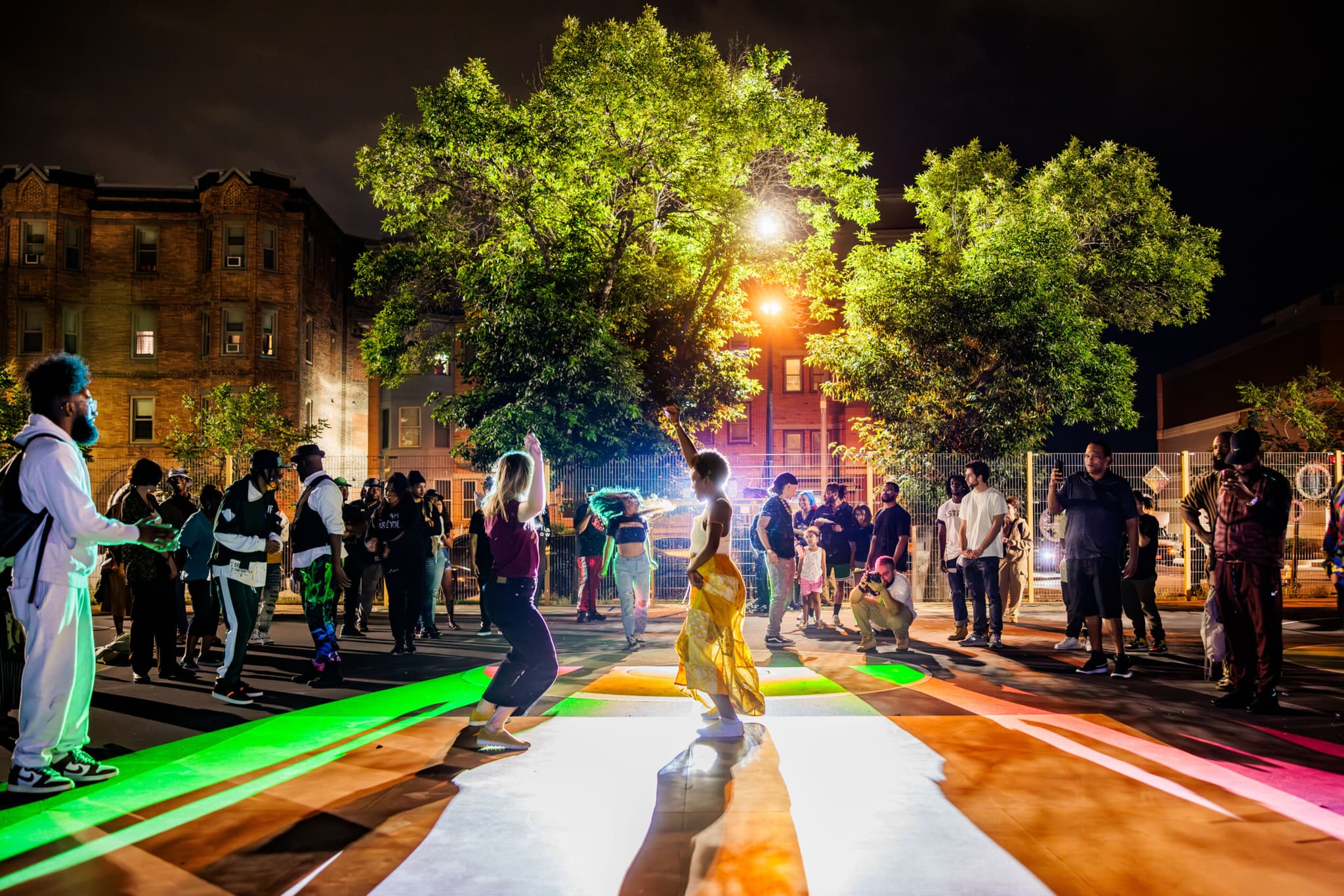
Dance Court (2022) at Mary Hannon Park sponsored by the Design Studio for Social Intervention and the Mayor’s Office of Arts and Culture. Produced and organized by Ashton “Stiggity Stackz” Lites from Stiggity Stackz Worldwide. Projections and staging by ILLUMINUS. Photography by Aram Boghosian.
That’s not the only public art project in the works for Dorchester: the city’s largest neighborhood will also be the first to experience a new incarnation of the Illuminus festival. Previous Illuminus events relied on immersive video activations to wow audiences, usually for just one or two nights only, in locations like Fenway Park and Downtown Crossing. Now, Illuminus has relaunched after a hiatus with a mission of making high-tech public art available to artists from all backgrounds and experience levels—and most crucially—from all neighborhoods. For its roving festival, Illuminus will use local curators and creative organizations to select emerging artists to collaborate with in each location.
Jeff Grantz, who heads Illuminus, is motivated by the process of bringing people together through developing large-scale, experiential art. “You get to shift reality and present the world through a different lens and then share in that new version of reality together,” Grantz explained. A festival in each neighborhood could bring people into spaces they’re less familiar with and help foster newfound appreciation for the communities who live there.
The importance of ownership—of histories, belonging, places, and spaces—is an undercurrent in the development of public art. With temporary and more permanent pieces, the theme of aesthetic justice has echoed across the city and the nation, particularly during the pandemic’s early days with the protesting and removal of historical monuments in 2020. But as humanity marches on, the definitions of what pleases and offends morph. How do we account for such shifts?
Jasper A. Sanchez, assistant curator at the Boston Public Art Triennial (formerly Now + There), which commissions temporary, site-specific art, recalled reading something poignant in response to Hank Willis Thomas’s Boston Common sculpture The Embrace. Sanchez said the gist was that public art shouldn’t be dedicated to people or events but to ideas. “I think that’s really accessible,” they said.
The Triennial’s Lot Lab project will bring the work of three artists, Matthew Okazaki, Ifé Franklin, and Hugh Hayden, to Charlestown’s Navy Yard in June. All three projects center on the theme of presence. “One way to think of presence is through monuments, known for grandeur or how much space they take up,” said Sanchez. “But we’re also thinking of presence as gathering, as community, as being present for each other and creating systems of support for each other.” Sanchez shared that some of the artists are responding to presence in a more critical way, contending with the presence of trauma and violent stories embedded in communities, histories, and narratives.
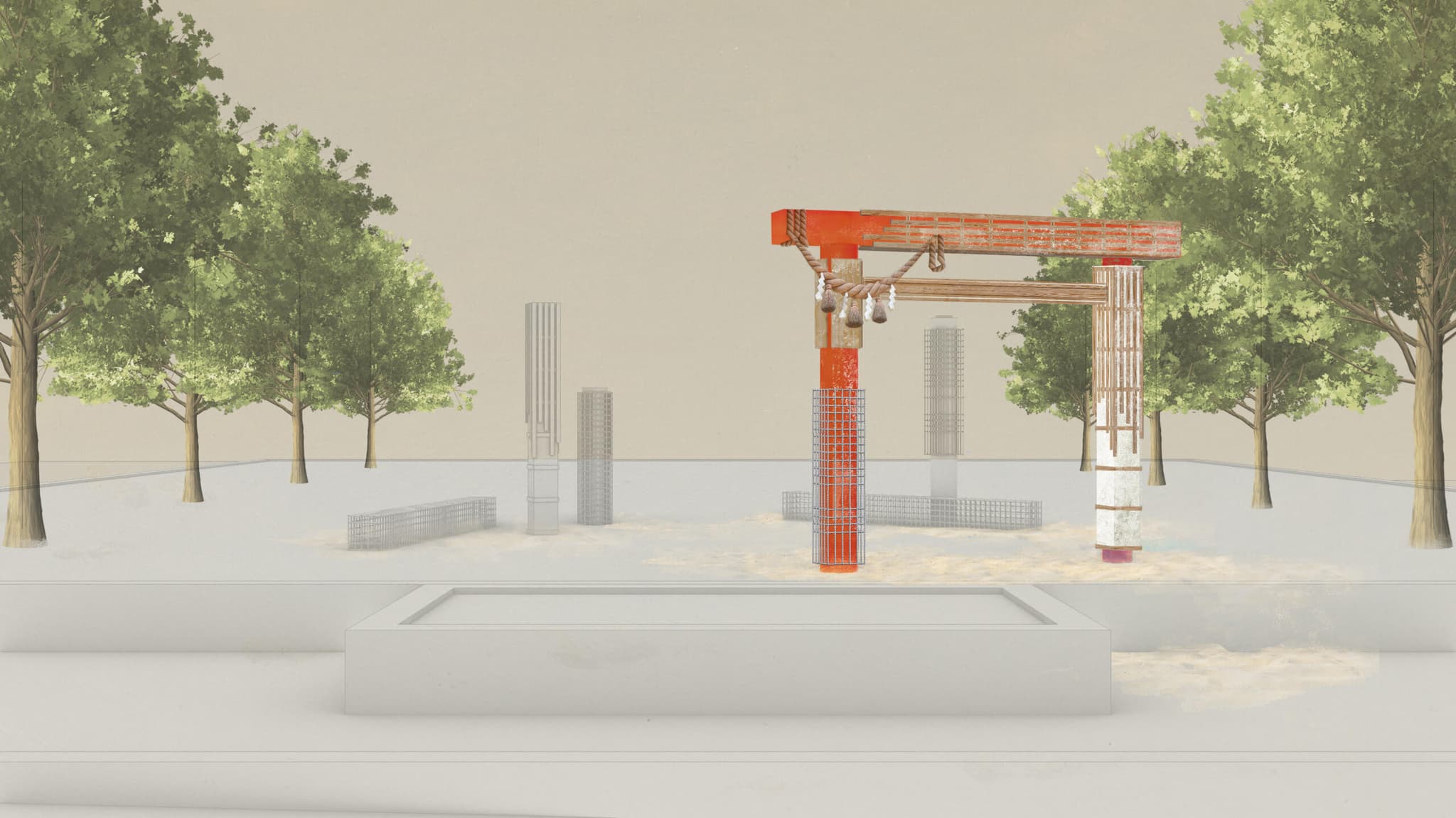
Early perspective rendering of Torii by Matthew Okazaki for Boston Public Art Triennial’s Lot Lab. Courtesy of the artist.
Hayden’s work, Gulf Stream, was created in 2022, but the two other projects are new commissions by local artists, and both offer opportunities for public participation. Okazaki is developing a work called Torii. A torii, a traditional Japanese gate often found at the entrance of a Shinto shrine, marks the transition from secular to sacred. Okazaki’s torii is a counterpoint to an existing inaccurate gate onsite. The work is informed by the histories of Japanese communities who lived in Charlestown at the beginning of the twentieth century and late nineteenth century, the artist’s family history, and the practice of marginalized communities making do with the materials they have on hand to beautify and dignify their spaces. The public-engagement element of the installation, led by Boston-based artist Maria Fong, is inspired by shide, zigzag paper streamers marking holy places. For this, Fong is exploring ways of using Tyvek—a durable synthetic paper-like material—to attach community responses to the torii. Franklin’s work, The Resurrection of Mark, Phillis, & Phebe, will speak to the lives and resistance of three people enslaved by John Codman in the 1700s who conspired to poison their owner to escape daily trauma but were caught. Mark was hanged in an iron gibbet, and his body was displayed for years. For the piece, Franklin will create a gibbet-inspired cocoon covered in vibrant àdìrẹ textiles and suspended from the middle of a tall structure. The cocoon aims to be a story of transformation, turning their story of violence and pain into one of beauty, growth, and healing, Sanchez offered. Around Juneteenth, a public procession will be held, followed by a grounding meditation and sound bath.
There’s no perfect process to create public artwork to please all. Still, the Mayor’s Office of Arts and Culture (MOAC) is committed to engaging in dialogue with communities across Boston to try. For its new initiative “Un-monument | Re-monument | De-monument: Transforming Boston,” MOAC put out a call in March for proposals for augmented reality workshops, new temporary monuments, and “un-monuments” in dialogue with existing monuments. Funded by the Mellon Foundation Monuments Project’s $3 million grant to the city, the initiative will feature partner-commissioned work, public talks, engagement activities, and an advisory board.
In the meantime, MOAC has partnered with a number of local institutions that have other public-art projects in the works, including the National Center of Afro-American Artists (NCAAA), the North American Indian Center of Boston (NAICOB), the Pao Arts Center, and Emerson Contemporary. Several Black artists will collaborate on an NCAAA-led project that includes an exhibition with murals on the museum’s grounds and a forum, while NAICOB will reactivate its building in Jamaica Plain as a monument. The Pao Arts Center will offer temporary public art and performance-based events curated by local artist Lani Asunción; the goal is to amplify experiences of the Asian American Pacific Islander community in Boston and preserve and celebrate Chinatown as a neighborhood, cultural hub, and monument. And Emerson Contemporary is commissioning a public art campaign by artist and educator Kameelah Janan Rasheed to respond to various Boston monuments through digital and analog exhibitions in transportation ad spaces.
All these public art pieces—crafted through research, story, and collaboration across mediums—might enliven a space temporarily, but it’s the chance connections made through assembly to witness and engage with the art that can last long after a work is dismantled or washed away.





